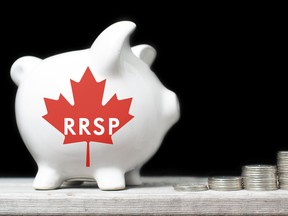Jamie Golombek: Here is what you want to learn about Canada’s latest registered financial savings plan

Opinions and suggestions are unbiased and merchandise are independently chosen. Postmedia might earn an affiliate fee from purchases made via hyperlinks on this web page.
Article content material
April 1 marked the official launch date of the tax-free first dwelling financial savings account (FHSA), Canada’s latest registered financial savings plan. As monetary establishments begin providing these within the weeks and months forward, listed below are 5 issues you want to know to take full benefit of those new plans.
Commercial 2
Article content material
Tax-free in; tax-free out
Article content material
The 2023 federal finances description of “tax-free in; tax-free out” succinctly summarizes the attractiveness of the FHSA, which supplies potential first-time homebuyers the flexibility to contribute as much as $40,000 and save on a tax-free foundation in direction of the acquisition of a primary dwelling in Canada.
The FHSA combines the most effective options of each the registered retirement financial savings plan (RRSP), which is a tax-deductible contribution, and the tax-free financial savings account (TFSA), which is the tax-free withdrawal of all contributions, funding revenue and development earned within the account when used to purchase a primary dwelling.
The FHSA can stay open for as much as 15 years or till the tip of the yr you flip 71. Any funds within the FHSA not used to purchase a qualifying dwelling by this time can then be transferred on a tax-deferred foundation into an RRSP or registered retirement revenue fund (RRIF), or withdrawn on a taxable foundation.
Article content material
Commercial 3
Article content material
What’s a first-time homebuyer?
As well as, you have to be a first-time homebuyer, that means you and your partner or associate haven’t owned a principal residence the place you lived throughout the calendar yr earlier than the account is opened or within the previous 4 calendar years.
How a lot can I contribute?
For those who qualify, you’re capable of contribute as a lot as $8,000 per yr, as much as the $40,000 lifetime contribution restrict. There’s a penalty tax of 1 per cent per 30 days for any overcontributions. The annual restrict applies to contributions made inside a specific calendar yr since, not like RRSPs, contributions made inside the first 60 days of a subsequent yr can’t be deducted within the present tax yr.
And, identical to RRSP contributions, you don’t have to say the FHSA deduction within the yr you make the contribution. The contribution will be carried ahead indefinitely and deducted in a later tax yr, which can make sense when you anticipate to be in a better tax bracket sooner or later.
Commercial 4
Article content material
Don’t have the money to contribute $8,000 per yr to a FHSA? No drawback. The principles allow you to switch funds from an current RRSP to an FHSA on a tax-free foundation, topic to the FHSA annual and lifelong contribution limits. These transfers aren’t tax deductible (you have been already entitled to say a tax deduction when the funds have been contributed to your RRSP), and the transfers gained’t reinstate your RRSP contribution room.

The principles additionally allow you to hold ahead any unused portion of the yr’s annual contribution restrict, as much as a most of $8,000. Because of this when you contribute (or switch) lower than $8,000 in a given yr, you possibly can then contribute the unused quantity in a future yr (as much as a most of $8,000) along with your annual contribution restrict of $8,000 (topic to the $40,000 lifetime restrict). Notice that carry-forward quantities solely begin accumulating after you open an FHSA for the primary time.
Commercial 5
Article content material
For example, let’s say Jake contributes $1,000 to his FHSA in 2023. In 2024, he’ll be capable to contribute one other $15,000 to his FHSA (that’s, $8,000 for 2024, plus the unused $7,000 of room from 2023). Nonetheless, if he fails to contribute something additional in 2024, he could be restricted within the following yr to $16,000, comprising the $8,000 for 2025 and $8,000 of carry-forward room from 2024.
What when you don’t purchase a house?
Your FHSA can stay open for as much as 15 years or till the tip of the yr if you flip 71 years previous, whichever comes first. Any funds left within the FHSA that aren’t used to purchase a qualifying dwelling earlier than closing the FHSA will be transferred on a tax-free foundation to an RRSP (with out impacting your RRSP room) or RRIF, or will likely be included in revenue.
Commercial 6
Article content material
Because of this for qualifying first-time homebuyers, contributing to an FHSA is actually with out threat (ignoring any threat taken on how the funds within the FHSA are invested). For those who don’t find yourself shopping for a house, you then successfully get one other $40,000 (plus development) of RRSP room and revel in as much as a 15-year tax deferral. All renters who qualify ought to take into account contributing $8,000 to an FHSA slightly than to their RRSP even when they don’t plan to ever to purchase a house as a result of they primarily get further RRSP room.
-

Modifications to three registered financial savings plans might have an effect on the way you make investments
-

CRA dings taxpayer for RRSP overcontribution tax on financial institution error
-

Why investing in an RRSP does make sense for a lot of Canadians
What in regards to the Dwelling Consumers’ Plan (HBP)?
Commercial 7
Article content material
Excellent news. The HBP, which lets first-time homebuyers withdraw as much as $35,000 from an RRSP to purchase a primary dwelling and pay it again, curiosity free over 15 years, will proceed to be accessible. Beneath the ultimate FHSA guidelines, the federal government now lets you take part in each the HBP and the FHSA for a similar dwelling buy, one thing that wasn’t initially allowed when the principles have been first launched.
Jamie Golombek, CPA, CA, CFP, CLU, TEP, is the managing director, Tax & Property Planning with CIBC Non-public Wealth in Toronto. Jamie.Golombek@cibc.com.
_____________________________________________________________
For those who preferred this story, join extra within the FP Investor e-newsletter.
_____________________________________________________________




Feedback
Postmedia is dedicated to sustaining a vigorous however civil discussion board for dialogue and encourage all readers to share their views on our articles. Feedback might take as much as an hour for moderation earlier than showing on the location. We ask you to maintain your feedback related and respectful. We now have enabled e mail notifications—you’ll now obtain an e mail when you obtain a reply to your remark, there may be an replace to a remark thread you observe or if a person you observe feedback. Go to our Group Pointers for extra data and particulars on find out how to modify your e mail settings.
Be part of the Dialog